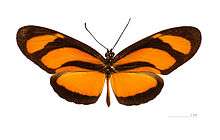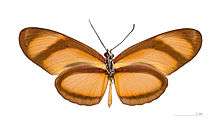Eueides lybia
| Lybia Longwing | |
|---|---|
 | |
| Dorsal view | |
 | |
| Ventral view | |
| Scientific classification | |
| Kingdom: | Animalia |
| Phylum: | Arthropoda |
| Class: | Insecta |
| Order: | Lepidoptera |
| Family: | Nymphalidae |
| Subfamily: | Heliconiinae |
| Genus: | Eueides |
| Species: | E. lybia |
| Binomial name | |
| Eueides lybia (Fabricius, 1775) | |
| Synonyms | |
| |
The Lybia Longwing (Eueides lybia) is a butterfly of the Nymphalidae family. It was described by Fabricius in 1775. It is found from Central America to northern South America,[1] from Nicaragua to Bolivia.
Adults feed on flower nectar of Lantana and Psiguria species. They spend most of the time in the forest canopy.
The larvae feed on solitarily Passiflora vitifolia. They are black with white patches on the thorax and anal segment and a yellowish stripe along the sides. The head is black. Pupation takes place in a white pupa which is suspended by the cremaster from a leaf.[2]
Subspecies
- Eueides lybia lybia (Surinam)
- Eueides lybia lybioides Staudinger, 1876 (Costa Rica, Panama)
- Eueides lybia olympia (Fabricius, 1793) (Nicaragua to Colombia)
- Eueides lybia orinocensis Brown & Fernández, 1985 (Venezuela)
- Eueides lybia otelloi Brown & Fernández, 1985 (Venezuela)
- Eueides lybia salcedoi Brown & Fernández, 1985 (Venezuela)
References
- ↑ Eueides lybia, funet.fi
- ↑ Eueides lybia, Learn about Butterflies
This article is issued from Wikipedia - version of the 11/7/2014. The text is available under the Creative Commons Attribution/Share Alike but additional terms may apply for the media files.